Chapter 2 Pragmatics 语用学
- 格式:ppt
- 大小:596.50 KB
- 文档页数:69
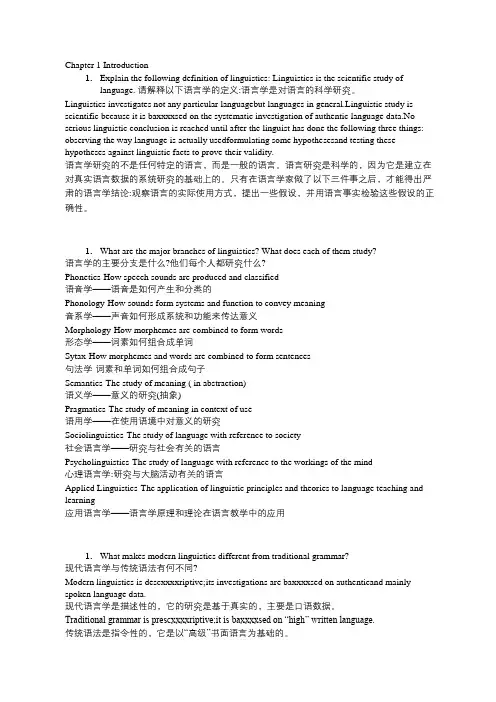
Chapter 1 Introduction1.Explain the following definition of linguistics: Linguistics is the scientific study oflanguage. 请解释以下语言学的定义:语言学是对语言的科学研究。
Linguistics investigates not any particular languagebut languages in general.Linguistic study is scientific because it is baxxxxsed on the systematic investigation of authentic language data.No serious linguistic conclusion is reached until after the linguist has done the following three things: observing the way language is actually usedformulating some hypothesesand testing these hypotheses against linguistic facts to prove their validity.语言学研究的不是任何特定的语言,而是一般的语言。
语言研究是科学的,因为它是建立在对真实语言数据的系统研究的基础上的。
只有在语言学家做了以下三件事之后,才能得出严肃的语言学结论:观察语言的实际使用方式,提出一些假设,并用语言事实检验这些假设的正确性。
1.What are the major branches of linguistics? What does each of them study?语言学的主要分支是什么?他们每个人都研究什么?Phonetics-How speech sounds are produced and classified语音学——语音是如何产生和分类的Phonology-How sounds form systems and function to convey meaning音系学——声音如何形成系统和功能来传达意义Morphology-How morphemes are combined to form words形态学——词素如何组合成单词Sytax-How morphemes and words are combined to form sentences句法学-词素和单词如何组合成句子Semantics-The study of meaning ( in abstraction)语义学——意义的研究(抽象)Pragmatics-The study of meaning in context of use语用学——在使用语境中对意义的研究Sociolinguistics-The study of language with reference to society社会语言学——研究与社会有关的语言Psycholinguistics-The study of language with reference to the workings of the mind心理语言学:研究与大脑活动有关的语言Applied Linguistics-The application of linguistic principles and theories to language teaching and learning应用语言学——语言学原理和理论在语言教学中的应用1.What makes modern linguistics different from traditional grammar?现代语言学与传统语法有何不同?Modern linguistics is descxxxxriptive;its investigations are baxxxxsed on authenticand mainly spoken language data.现代语言学是描述性的,它的研究是基于真实的,主要是口语数据。
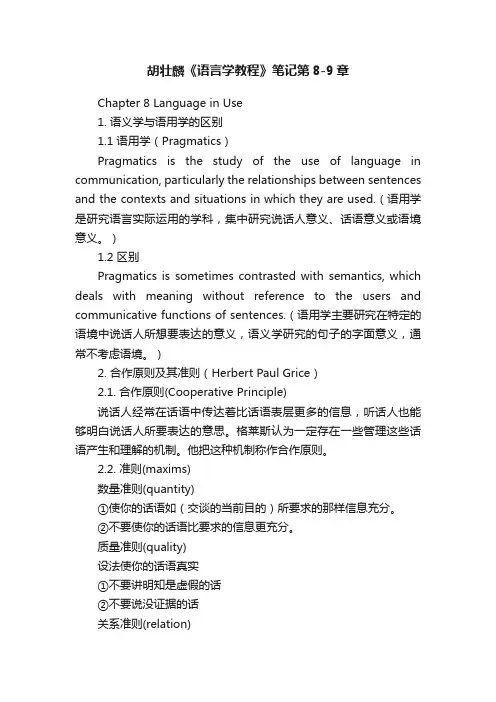
胡壮麟《语言学教程》笔记第8-9章Chapter 8 Language in Use1. 语义学与语用学的区别1.1 语用学(Pragmatics)Pragmatics is the study of the use of language in communication, particularly the relationships between sentences and the contexts and situations in which they are used.(语用学是研究语言实际运用的学科,集中研究说话人意义、话语意义或语境意义。
)1.2 区别Pragmatics is sometimes contrasted with semantics, which deals with meaning without reference to the users and communicative functions of sentences.(语用学主要研究在特定的语境中说话人所想要表达的意义,语义学研究的句子的字面意义,通常不考虑语境。
)2. 合作原则及其准则(Herbert Paul Grice)2.1. 合作原则(Cooperative Principle)说话人经常在话语中传达着比话语表层更多的信息,听话人也能够明白说话人所要表达的意思。
格莱斯认为一定存在一些管理这些话语产生和理解的机制。
他把这种机制称作合作原则。
2.2. 准则(maxims)数量准则(quantity)①使你的话语如(交谈的当前目的)所要求的那样信息充分。
②不要使你的话语比要求的信息更充分。
质量准则(quality)设法使你的话语真实①不要讲明知是虚假的话②不要说没证据的话关系准则(relation)所谈内容要密切相关方式准则(manner)要清晰。
①避免含糊不清②避免歧义③要简练(避免冗长)④要有序3. 言语行为理论(Speech Act Theory)---John Austin3.1. 施为句&叙事句(Performatives & Constatives)施为句是用来做事的,既不陈述事实,也不描述情况,且不能验证真假;叙事句要么用于陈述,要么用于验证,可以验证真假。
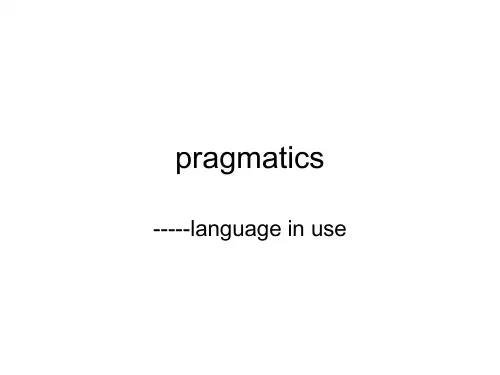
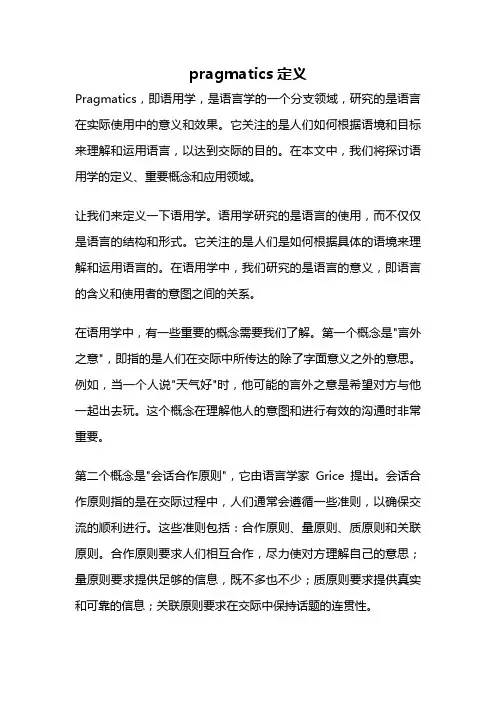
pragmatics定义Pragmatics,即语用学,是语言学的一个分支领域,研究的是语言在实际使用中的意义和效果。
它关注的是人们如何根据语境和目标来理解和运用语言,以达到交际的目的。
在本文中,我们将探讨语用学的定义、重要概念和应用领域。
让我们来定义一下语用学。
语用学研究的是语言的使用,而不仅仅是语言的结构和形式。
它关注的是人们是如何根据具体的语境来理解和运用语言的。
在语用学中,我们研究的是语言的意义,即语言的含义和使用者的意图之间的关系。
在语用学中,有一些重要的概念需要我们了解。
第一个概念是"言外之意",即指的是人们在交际中所传达的除了字面意义之外的意思。
例如,当一个人说"天气好"时,他可能的言外之意是希望对方与他一起出去玩。
这个概念在理解他人的意图和进行有效的沟通时非常重要。
第二个概念是"会话合作原则",它由语言学家Grice提出。
会话合作原则指的是在交际过程中,人们通常会遵循一些准则,以确保交流的顺利进行。
这些准则包括:合作原则、量原则、质原则和关联原则。
合作原则要求人们相互合作,尽力使对方理解自己的意思;量原则要求提供足够的信息,既不多也不少;质原则要求提供真实和可靠的信息;关联原则要求在交际中保持话题的连贯性。
语用学在现实生活中有许多重要的应用领域。
其中之一是交际策略。
交际策略是指人们在交际过程中采取的一些技巧和方法,以实现自己的交际目的。
例如,当一个人想要请求帮助时,他可以使用委婉语言来表达请求,以增加对方的接受度。
交际策略的研究可以帮助人们更好地理解和运用语言,从而提高交际的效果。
另一个应用领域是语言教学。
语用学可以帮助教师更好地教授语言,使学生能够真正地理解和运用语言。
通过教授学生一些常见的交际策略和语用规则,学生能够更好地掌握语言的意义和使用方式。
这有助于提高他们的语言水平和交际能力。
语用学还在法律、广告和政治等领域有广泛的应用。
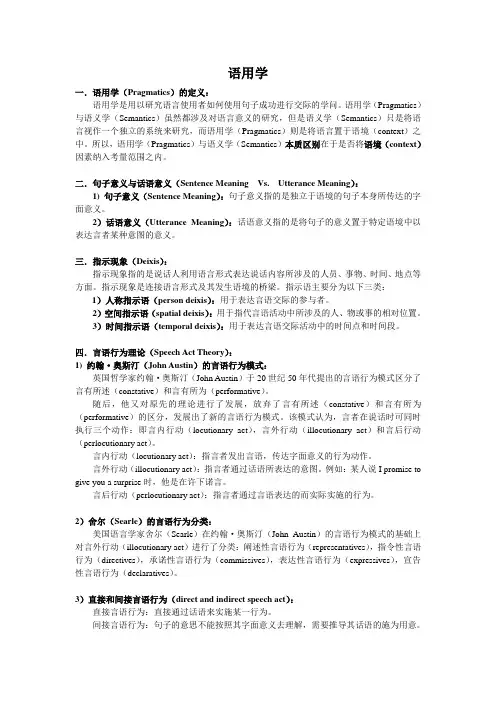
语用学一.语用学(Pragmatics)的定义:语用学是用以研究语言使用者如何使用句子成功进行交际的学问。
语用学(Pragmatics)与语义学(Semantics)虽然都涉及对语言意义的研究,但是语义学(Semantics)只是将语言视作一个独立的系统来研究,而语用学(Pragmatics)则是将语言置于语境(context)之中。
所以,语用学(Pragmatics)与语义学(Semantics)本质区别在于是否将语境(context)因素纳入考量范围之内。
二.句子意义与话语意义(Sentence Meaning Vs. Utterance Meaning):1) 句子意义(Sentence Meaning):句子意义指的是独立于语境的句子本身所传达的字面意义。
2)话语意义(Utterance Meaning):话语意义指的是将句子的意义置于特定语境中以表达言者某种意图的意义。
三.指示现象(Deixis):指示现象指的是说话人利用语言形式表达说话内容所涉及的人员、事物、时间、地点等方面。
指示现象是连接语言形式及其发生语境的桥梁。
指示语主要分为以下三类:1)人称指示语(person deixis):用于表达言语交际的参与者。
2)空间指示语(spatial deixis):用于指代言语活动中所涉及的人、物或事的相对位置。
3)时间指示语(temporal deixis):用于表达言语交际活动中的时间点和时间段。
四.言语行为理论(Speech Act Theory):1) 约翰·奥斯汀(John Austin)的言语行为模式:英国哲学家约翰·奥斯汀(John Austin)于20世纪50年代提出的言语行为模式区分了言有所述(constative)和言有所为(performative)。
随后,他又对原先的理论进行了发展,放弃了言有所述(constative)和言有所为(performative)的区分,发展出了新的言语行为模式。
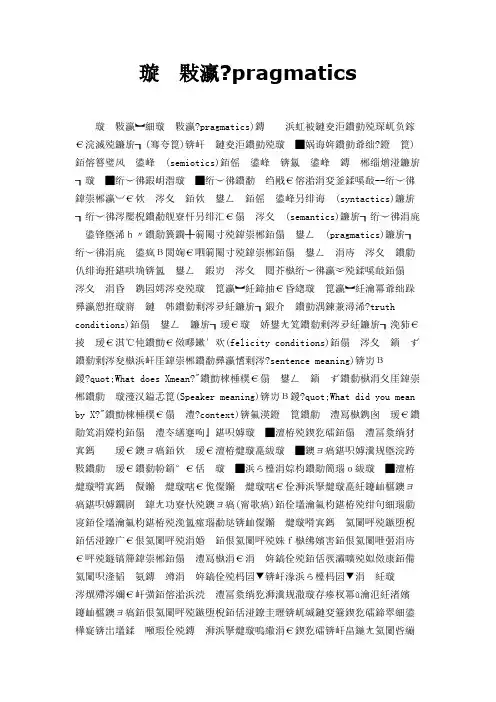
语用学pragmatics语用学:语用学(pragmatics)是对人类有目的的行为所作的研究(广义),对有目的的语言活动的研究(狭义)。
源起符号学(semiotics)。
符号学:符号学是系统地研究语言符号和非语言符号的学科。
有三个分支--符号关系学、语义学、语用学。
符号关系学(syntactics)研究符号之间的形式关系。
语义学(semantics)研究符号与符号所代表的事物之间的关系。
语用学(pragmatics)研究符号与符号解释者之间的关系。
语用学与语义学的联系和区别:语用学和语义学都是符号学的分支。
语义学主要指狭义的语义学,即逻辑语义学,它研究句子和词语本身的意义,研究命题的真值条件(truth conditions)。
语用学研究言语使用上的意义,研究传递语言信息的适宜条件(felicity conditions)。
语义学揭示的意义是二元关系的句子意义(sentence meaning),解决"Whatdoes Xmean?"的问题。
语用学揭示的是三元关系的说话人意义(Speaker meaning),解决"What did you mean by X?"的问题。
语境(context):最狭义的语境是指语言的上下文。
语境还必须包括语言外的因素。
语境因素包括语言知识、语言外知识;语言知识包括对所使用的语言的掌握、对语言交际上文的了解;语言外知识包括背景知识、情景知识、相互知识,背景知识包括百科全书式的知识(常识)、特定文化的社会规范、特定文化的会话规则,情景知识包括交际的时间、地点、交际的主题、交际的正是程度、交际参与者的相互关系。
语境是一个动态的、发展的概念。
交际本身就是一个动态的过程,在交际过程中,语境也随之而变。
有些语境因素相对来说比较稳定,例如背景知识、交际的时间、地点等,但有些因素却会变化,特别重要的是相互知识这一因素,它在交际过程中不断扩大,原来不为双方所共有的知识完全可能在交际过程中变为相互知识,成为进一步交际的基础。
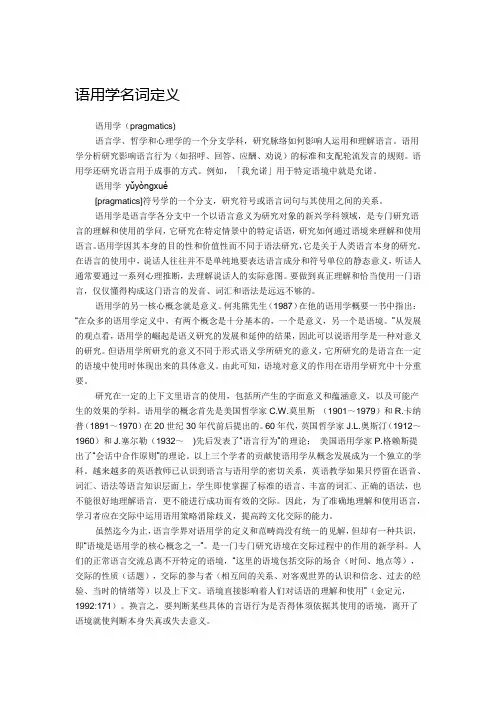
语用学名词定义语用学(pragmatics)语言学、哲学和心理学的一个分支学科,研究脉络如何影响人运用和理解语言。
语用学分析研究影响语言行为(如招呼、回答、应酬、劝说)的标准和支配轮流发言的规则。
语用学还研究语言用于成事的方式。
例如,「我允诺」用于特定语境中就是允诺。
语用学yǔyòngxué[pragmatics]符号学的一个分支,研究符号或语言词句与其使用之间的关系。
语用学是语言学各分支中一个以语言意义为研究对象的新兴学科领域,是专门研究语言的理解和使用的学问,它研究在特定情景中的特定话语,研究如何通过语境来理解和使用语言。
语用学因其本身的目的性和价值性而不同于语法研究,它是关于人类语言本身的研究。
在语言的使用中,说话人往往并不是单纯地要表达语言成分和符号单位的静态意义,听话人通常要通过一系列心理推断,去理解说话人的实际意图。
要做到真正理解和恰当使用一门语言,仅仅懂得构成这门语言的发音、词汇和语法是远远不够的。
语用学的另一核心概念就是意义。
何兆熊先生(1987)在他的语用学概要一书中指出:―在众多的语用学定义中,有两个概念是十分基本的,一个是意义,另一个是语境。
‖从发展的观点看,语用学的崛起是语义研究的发展和延伸的结果,因此可以说语用学是一种对意义的研究。
但语用学所研究的意义不同于形式语义学所研究的意义,它所研究的是语言在一定的语境中使用时体现出来的具体意义。
由此可知,语境对意义的作用在语用学研究中十分重要。
研究在一定的上下文里语言的使用,包括所产生的字面意义和蕴涵意义,以及可能产生的效果的学科。
语用学的概念首先是美国哲学家C.W.莫里斯(1901~1979)和R.卡纳普(1891~1970)在20世纪30年代前后提出的。
60年代,英国哲学家J.L.奥斯汀(1912~1960)和J.塞尔勒(1932~)先后发表了―语言行为‖的理论;美国语用学家P.格赖斯提出了―会话中合作原则‖的理论。
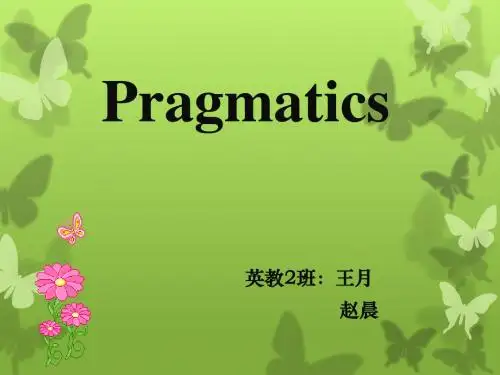
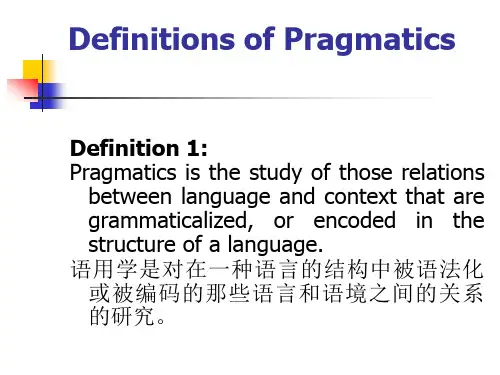
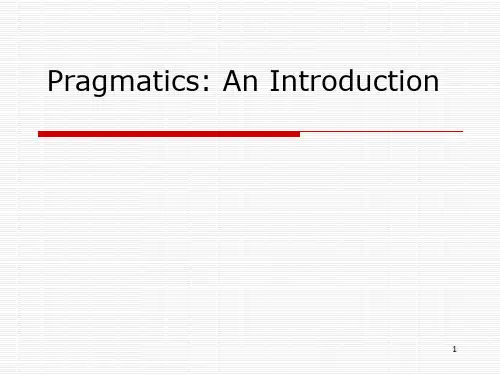

Chapter 1: Introduction1.Linguistics:语言学It is generally defined as the scientific study of language.( Linguistics studies not any particular language ,but it studies language in general)2。
General linguistics:普通语言学The study of language as a whole is called general linguistics。
(language is a complicated entity with multiple layers and facets )nguage:Language is a system of arbitrary vocal symbols used for human communication。
4.descriptive (描述性):A linguistic study aims to describe and analyze the language people actually use。
5。
prescriptive(规定性): It aims to lay down rules for “correct and standard” behaviors。
i.e。
what they should say and what they should not to say.6。
synchronic(共时语言学):the description of language at some point of time in hiatory7。
diachronic (历时语言学):the description of language as it changes through time 3)speech(口语)Writing(书面语)These the two media of communication。
自考《现代语言学》复习讲义一、常考题型1.填空2.单项选择3.判断正误4.解释词语并举例说明对名词解释并举一两个例子进行说明5.回答问题做题要求:用英文进行答题。
二、各章节学习要点Chapter 1 Introduction (绪论)is linguisticsDefinition (语言学的定义)Linguistics is generally defined as the scientific study of language.Linguistics studies not any particular language, ., English, Chinese, Arabic, and Latin, but in language in general.The Scope of linguistics (语言学的研究范畴)—4The study of language as a whole is often called general linguistics(普通语言学).This deals with the basic concepts, theories, descriptions, models and methods applicable in any linguistic study, in contrast to those branches of study which relate linguistics tothe research of other areas.Main branches of linguistics 语言学的主要分支:1)phonetics(语音学) 2)phonology (音系学) 3)morphology (形态学) 4)syntax (句法学) 5)semantics (语义学) 6)pragmatics (语用学)The study of all these aspects of language forms the core of linguistics.Findings in linguistic studies can often be applie3d to the solution of such practical problems as the recovery of speech ability. The study of such applications is generally known as applied linguistics.Macrolinguistics 宏观语言学:1) Psycholingusitcs (心理语言学);2) Sociolinguistics (社会语言学);3) Anthropological linguistics (人类语言学);4) Computational linguistics (计算语言学)Some important distinctions in linguistics —71.3.1 Prescriptive vs. descriptive (规定性和描述性)Modern linguistics, ., linguistic study carried out in this century is mostly descriptive.1.3.2 Synchronic vs. diachronic (共时性和历时性)In modern linguistics, synchronic study seems to enjoy priority over diachronic study.1.3.3 Speech and writing (口头语和书面语)Speech and writing are the two major media of communication. Modern linguistics regards the spoken language as primary, not the written.1.3.4 Langue and parole (语言和言语)The distinction between langue and parole was made by the Swiss linguist F. de Saussure in the early 20th century.1.3.5 Competence and performance (语言能力和语言运用)Similar to Saussure’s distinction between langue and parole is the distinction between competence and performance, which was proposed by the American linguist N. Chomsky in the late 1950’s.While Saussure’s distinction and Chomsky’s are very similar, they differ at least in that Saussure took a sociological view of language and his notion of langue is a matter of social conventions, and Chomsky looks at language from a psychological point of view and to him competence is a property of the mind of each individual.2. What is languageDefinitions of languageLanguage is a system of arbitrary vocal symbols used for human communication.(语言是人类在交际中使用的一套任意的声音符号系统。
现代语言学(课程代码:00830)Chapter1:Introduction1.Define the following terms:1).Linguistics:It is generally defined as the scientific study of language.2).General linguistics(普通语言学):The study of language as a whole is called general linguistics.3).Applied linguistics(应用语言学):In a narrow sense,applied linguistics refers to the application of linguistic principles and theories to language teaching and learning,especially the teaching of foreign and second languages.In a broad sense,it refers to the application of linguistic findings to the solution of practical problems such as the recovery of speech ability.4).Synchronic study(共时性研究):The study of a language at some point in time.e.g.A study of the features of the English used in Shakespeare's time is a synchronic study.5).Diachronic study(历时性研究):The study of a language as it changes through time.A diachronic study of language is a historical study,which studies the historical development of language over a period of time.e.g.a study of the changes English has undergone since Shakespeare's time is a diachronic study. 6).Language competence(语言能力):The ideal user's knowledge of the rules of his language.A transformational-generative grammar(转化生成语法)is a model of language competence.7).Language performance(语言行为):performance is the actual realization of the ideal language user's knowledge of the rules in linguistic communication. 8).Langue(语言):Langue refers to the abstract linguistic system shared by all the members of a speech community;Langue is the set of conventions and rules which language users all have to follow;Langue is relatively stable,it does not change frequently.9).Parole(言语):Parole refers to the realization of langue in actual use;parole is the concrete use of the conventions and the application of the rules;parole varies from person to person,and from situation to situation.10).Language(语言):Language is a system of arbitrary vocal symbols used for human communication.11).Arbitrariness(任意性):It is one of the design features of language.It means that there is no logical connection between meanings and sounds.A good example is the fact that different sounds are used to refer to the same object in different languages.12).Productivity(多产性):Language is productive or creative in that it makes possible the construction and interpretation of new signals by its users.13).Duality(二元性):Language is a system,which consists of two sets of structure,or two levels,one of sounds at the lower or basic level,and the other of meanings at the higher level.14).Displacement(移位性):language can be used to refer to things which are present or not present,real or imagined matters in the past,present,or future,or in far-away places.In other words,language can be used to refer to contexts removed from the immediate situations of the speaker.15).Cultural transmission(文化传递性):While we are born with the ability to acquire language,the details of any language are not genetically transmitted,but instead have to be taught and learned.16).Design features(普遍特征):It refers to the defining properties of human language that distinguish it from any animal system of communication2.Explain the following definition of linguistics:Linguistics is the scientific study of language.Linguistics investigates not any particular language,but languages in general. Linguistic study is scientific because it is based on the systematic investigation of authentic(可靠的,真实的)language data.No serious linguistic conclusion is reached until after the linguist has done the following three things:observing the way language is actually used,formulating some hypotheses,and testing these hypotheses against linguistic facts to prove their validity.3.What are the branches of linguistics?What does each of them study?(语言学的主要分支是什么。